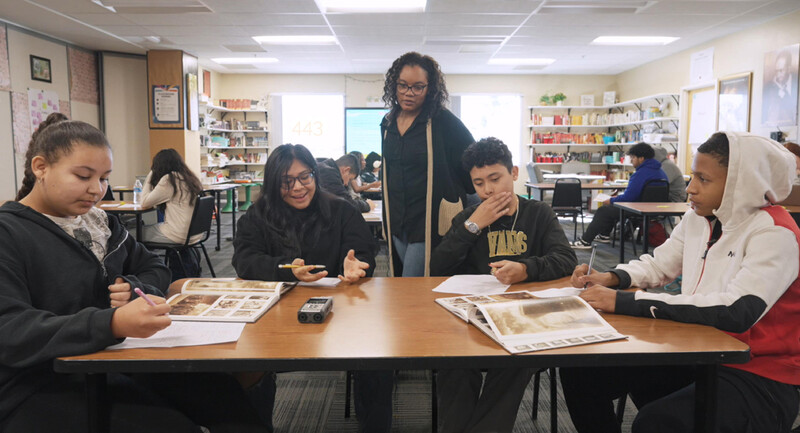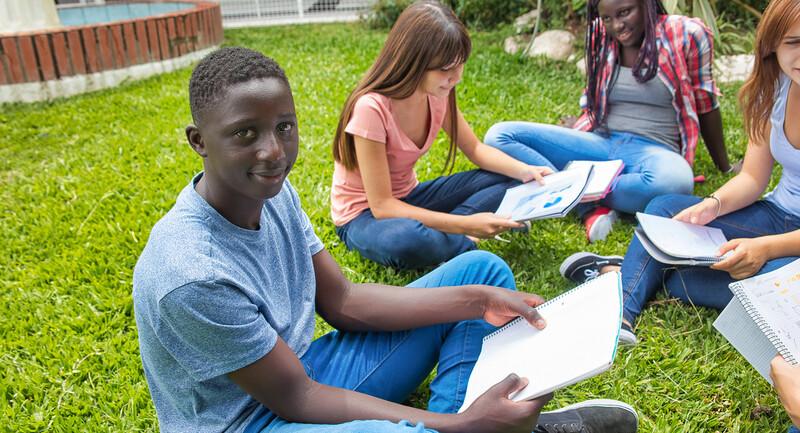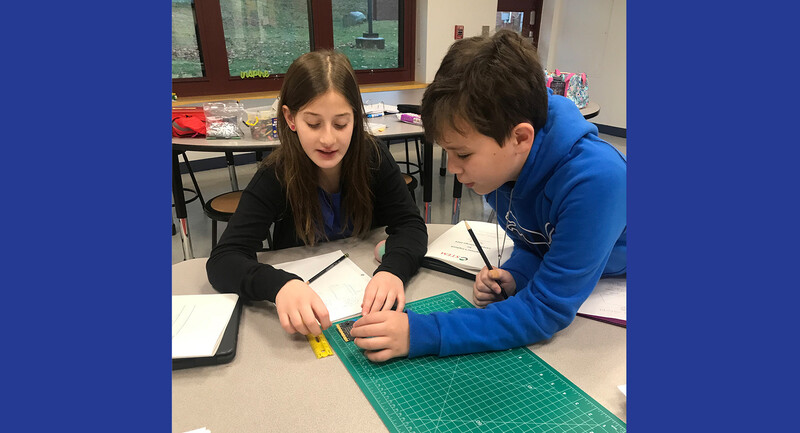For me, the phrase "unleashing problem solvers" brings to mind the barely contained energy of racehorses at the starting gate: The gates open, and the horses fly out of confinement, taking off in a display of their natural speed, grace, and ability. That's what it can feel like in a classroom where children are encouraged and expected to be masterful problem solvers. So how do we release the natural energy for problem solving within our students? In my classroom, I rely on five practices that help students develop critical thinking, creativity, communication skills, and collaboration skills—the "Four Cs" of 21st century learning (NEA, n.d.).
1. Think Systematically with Math Word Problems
Encouraging creative problem-solving practices can begin in math class. For example, I use a problem-solving strategy for math word problems called Read-Draw-Write in which my 2nd graders make sense of the problems by drawing what is happening, then analyzing the part-whole relationship of the numbers presented. Understanding this relationship, that a whole is made up of smaller parts, and that smaller parts can be joined to make a larger whole, helps reveal the mathematical operations that can be used to solve problems. For example, if I know Victoria has 12 red marbles (one part) and 7 green marbles (the other part), I add the parts together to find the whole, 19 marbles. Likewise, if I know the whole, or total, (19 marbles) and I know one part (7), I can count on from 7 up to 19 to find the missing part (12). I could also subtract 7 from 19 to find the missing part. Later on in the year, and in subsequent grades, students learn to apply this reasoning to determine whether to multiply or divide.
Helping students make sense of word problems is paramount, so we read each problem and ask, What do you know?, What can you draw?, and What conclusions can you reach from your drawings? One benefit of this method is that everyone can draw something, so everyone has access. In the example with the marbles, a student can draw 12 red marbles and 7 green marbles and then count them all to find the total.
In addition to the intuitive drawings that students make to represent what is happening in a word problem, they also learn to draw two part-whole models, the number bond and the tape diagram, also known as a bar model (see fig.1). The number bond is a visual model that shows the smaller parts connected to the larger whole. The tape diagram is drawn with rectangles, and the known quantities are labeled.
Figure
Consider the following word problem: Evvy's sunflower is 9 centimeters shorter than Julian's. Evvy's sunflower is 75 centimeters tall. How tall is Julian's sunflower? Figure 1 shows how a student used both a tape diagram and a number bond to represent the given information. Here, the whole is unknown and the parts are 75 and 9. These kinds of drawings help students see the relationships of the numbers. Modeling to help make sense of problems leads students to engage in deeper thinking, which in turn leads to deeper understanding (Boaler et al., 2016).
Another question that we ask with this type of comparison problem is, Who has more? This questioning, in conjunction with modeling, guides students to see that even though the word shorter suggests subtraction, both parts, 75 and 9, are known, which means we add the parts to find the answer: 75 + 9 = 84, so Julian sunflower is 84 centimeters tall.
Having solved the equation, students write the answer in a statement and then check their solution for reasonableness in the context of the word problem. Another benefit of this kind of problem solving is that it sharpens students' awareness of details. In the case shown in Figure 1, the student wrote, "Julian's sunflower is 84 long." The unit—centimeters—had been omitted. When this student shared her work with the class, another student asked, "84 what?" This kind of attention to detail is a key mathematical practice that hones critical thinking, one of the four Cs.
Approaching word problems in this systematic way that encourages students to draw to make sense of the information presented and to think about the relationships of the numbers involved has produced outstanding results in my classroom. For one thing, it short-circuits the former, and all-too-common, impulse my students had of simply adding whatever numbers they saw, or seeing words like less and simply subtracting without regard to context. The RDW process provides a structured way into any problem.
This is not an insignificant benefit. Research has linked math anxiety in students to future avoidance of math courses, which has implications for later career choices (Ramirez, et al., 2013). This was certainly true for me. I remember my own terror when faced with word problems as a child. My inability to make sense of the problems, of having no way to get started, led to an ever-worsening anxiety and fear about math, and my fear and lack of confidence only increased over time. Today, I thrill to see my students not just confident but eager to approach each day's new problem.
2. Choose the Right Strategy
My students love the challenge of looking for relationships and using what they know to solve problems in varied ways. This ability to think across contexts and make connections requires creativity, another of the 4 Cs. For instance, I asked my students to solve 430 – 129 = ___ using any strategy of their choosing. When they were ready, students took turns sharing their work and describing the strategies they used (fig. 2). Students explained their reasoning and responded to questions and critiques.
Figure
Colton used a strategy called compensation. He noticed that 129 is one away from 130, and it would be easy to subtract 130 from 430. He used a tape diagram to show that he can keep the difference between 430 and 129 the same, but make an easier problem to solve by adding 1 to each number: 430 – 129 is equal to 431 – 130. The answer is 301. Beverly and Nigel used versions of arrow notation, a means of recording the mental steps they were taking. Beverly counted on from 129 up to 430, by first adding 300 to get to 429, and then adding 1 more. Nigel counted back, breaking apart 129 and subtracting first 100, then 20, then 9. Dahlia used the standard algorithm, the customary way of solving column by column. Desmond said he used mental math, subtracting 100 from 400 to get 300, and 29 from 30 to get 1, then adding those parts together to get 301.
Taken together, the work shows wide-ranging creativity, rooted in the structure of our number system and an understanding of the relationship between the numbers. It also shows that these students are flexible thinkers and problem solvers. They know if one model or strategy doesn't work for them, they can try another. Developing this kind of skill—the ability to find the right strategy that works for you when confronted with a problem—is vital in math and virtually every other subject.
My students didn't develop the ability to reason about numbers like this overnight. In the words of a former mentor, Professor Yoram Sagher, "there's the long way that's short, and the short way that's long." This work is an example of the long way that's short. Getting to this place where students feel free to experiment with numbers and try different solution paths comes from the regular practice of looking at numbers relationally, and this means giving them time and space and encouragement to draw, to model, to notice, to wonder, to make connections, and to talk.
Figure 2 is from Number Talk, a routine in which students are given an equation to solve and allowed to use as many strategies as they can come up with. I chart as many as I can and then we discuss them. Students explain their thinking, justify their reasoning, question one another, and make connections among the strategies. Along the way, all students are seeing and hearing multiple representations and ways of thinking about numbers, which translates into more pathways being opened up, leading to greater access and understanding.
3. Work and Talk Together
My students know they will be expected to share their models and solution strategies. To do this, they use a few collaboration routines. One such routine is called "showdown" (Kagan, 2009). After reading a word problem together, students write on their individual dry-erase boards whether they know the parts, or the whole and one part. Then, they turn their boards facedown on the table. When every person at a table has turned their board over, the table's captain calls out "showdown," and they hold up their answers simultaneously. If all the students at any given table agree on a response, they stand up. This lets me know they are ready to move on to modeling and solving the problem.
If there is disagreement at a table, the students can't move on until they reach a consensus. They talk through their reasoning to prove or disprove their answers. Because the focus is on communication and collaboration, students learn to be specific in their explanations and in the questions they ask. It was the highlight of the day when I watched a student ask her teammate, "What do you know?" in connection with a problem posing that 29 cupcakes were sold at the fair, and 19 were left over. Then she asked, "OK, what can you draw?" She patiently guided her friend to see through her own drawing that she knew the parts and so needed to add to find how many cupcakes were brought to the fair.
Creativity and understanding are strengthened through collaboration, and the practice of sharing thinking and explaining reasoning helps develop both communication and collaboration skills, the remaining Cs. Because problem solving is so often a team effort in the real world, it's good to start children on this path as early as possible.
4. Learn from Mistakes
The fear of making mistakes is an impediment to creativity, communication, and the kind of risk-taking necessary to solve challenging problems. In my classroom, we celebrate the usefulness of mistakes. I read my students books about the elasticity of the brain, like Your Fantastic Elastic Brain: Stretch It, Shape It (Deak, 2010) and about mistakes that led to discoveries like the light bulb and the chocolate chip cookie, such as Mistakes that Worked: The World's Familiar Inventions and How They Came to Be (Foltz Jones, 1991).
I also use a practice called "my favorite mistake." I choose an error that is either common or that exemplifies a misconception. Then we break it down to figure out where the problem is.
In addition, students who catch me making a mistake earn high praise, much to their delight. Recently, while sharing math strategies with one another, one student shared a method that I mistakenly thought didn't work. He persisted in explaining his thinking until I finally saw the light. He was right! This was cause for celebration because he had done something magnificent, something I would never have dreamed of doing as a child—he questioned the validity of his teacher's response. That kind of perseverance and confidence is invaluable.
5. Create a Problem-Solving Culture
The best way to build a thriving problem-solving culture is to give students problems they want to solve. Worksheets won't get the job done. As the final investigation of our science unit on motion, my students worked together to create a runway stretching across the classroom on which a marble could successfully roll through from beginning to end. I gave them masking tape and segments of styrofoam tubing that were split in half to form a groove for the marble to roll through. The runway needed to contain loops, twists, and bends. With no assistance from me, except for the continual passing out of tape, the students deduced through experimentation that if they started the marble from a high enough point to gain sufficient momentum, it would roll through the entire course. And it did! I was as excited as they were as I watched them figure out how to raise the ramp here, stabilize it there, and negotiate how to add a twist without slowing the marble down. Whenever the marble fell off track or stopped, one of the students was right there to fix the situation.
I've also presented students with real-life scenarios that play out in our classroom. Our class is in a very small bungalow, and space is tight. There isn't room for lunchboxes and backpacks, so we pile everything under the students' tables, which can cause students to trip. That led me to ask the class, "How can we solve the backpack problem?"
Without prompting, Ivy immediately made a drawing showing a box divided into 24 squares, with a circle in each square. She labeled her drawing to show that the circles represented backpacks and explained that we should build something like a bookcase outside. Another student suggested that we attach a plastic sheet that could be rolled up when it's sunny and let down when it rains. Ivy took this suggestion and added it to her picture. I sent her to the principal to present her solution, and she came back beaming because he said he would consider it.
For students like Ivy, gaining a sense of efficacy at such a young age means having that much more time to develop these abilities and carry them into the world. Imagine all the ways these 7- and 8-year-olds will be able to contribute to society as adults. Lucky them. Lucky us.







